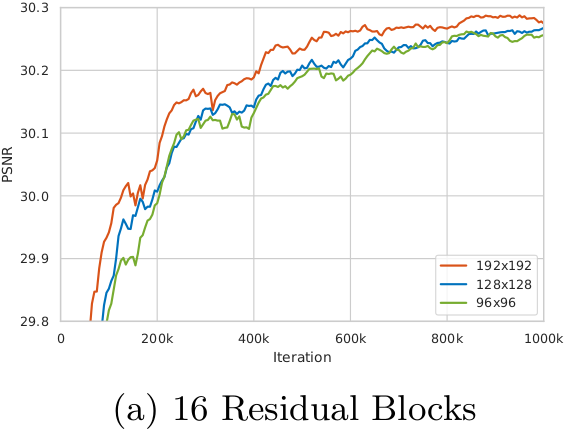# ESRGAN (Enhanced SRGAN) [[Paper]](https://arxiv.org/abs/1809.00219) [[BasicSR]](https://github.com/xinntao/BasicSR)
## :smiley: Training codes are in [BasicSR](https://github.com/xinntao/BasicSR) repo.
### Enhanced Super-Resolution Generative Adversarial Networks
By Xintao Wang, [Ke Yu](https://yuke93.github.io/), Shixiang Wu, [Jinjin Gu](http://www.jasongt.com/), Yihao Liu, [Chao Dong](https://scholar.google.com.hk/citations?user=OSDCB0UAAAAJ&hl=en), [Yu Qiao](http://mmlab.siat.ac.cn/yuqiao/), [Chen Change Loy](http://personal.ie.cuhk.edu.hk/~ccloy/)
This repo only provides simple testing codes, pretrained models and the network strategy demo.
### **For full training and testing codes, please refer to [BasicSR](https://github.com/xinntao/BasicSR).**
We won the first place in [PIRM2018-SR competition](https://www.pirm2018.org/PIRM-SR.html) (region 3) and got the best perceptual index.
The paper is accepted to [ECCV2018 PIRM Workshop](https://pirm2018.org/).
#### BibTeX
@InProceedings{wang2018esrgan,
author = {Wang, Xintao and Yu, Ke and Wu, Shixiang and Gu, Jinjin and Liu, Yihao and Dong, Chao and Qiao, Yu and Loy, Chen Change},
title = {ESRGAN: Enhanced super-resolution generative adversarial networks},
booktitle = {The European Conference on Computer Vision Workshops (ECCVW)},
month = {September},
year = {2018}
}

The **RRDB_PSNR** PSNR_oriented model trained with DF2K dataset (a merged dataset with [DIV2K](https://data.vision.ee.ethz.ch/cvl/DIV2K/) and [Flickr2K](http://cv.snu.ac.kr/research/EDSR/Flickr2K.tar) (proposed in [EDSR](https://github.com/LimBee/NTIRE2017))) is also able to achive high PSNR performance.
| Method | Training dataset | Set5 | Set14 | BSD100 | Urban100 | Manga109 |
|:---:|:---:|:---:|:---:|:---:|:---:|:---:|
| [SRCNN](http://mmlab.ie.cuhk.edu.hk/projects/SRCNN.html)| 291| 30.48/0.8628 |27.50/0.7513|26.90/0.7101|24.52/0.7221|27.58/0.8555|
| [EDSR](https://github.com/thstkdgus35/EDSR-PyTorch) | DIV2K | 32.46/0.8968 | 28.80/0.7876 | 27.71/0.7420 | 26.64/0.8033 | 31.02/0.9148 |
| [RCAN](https://github.com/yulunzhang/RCAN) | DIV2K | 32.63/0.9002 | 28.87/0.7889 | 27.77/0.7436 | 26.82/ 0.8087| 31.22/ 0.9173|
|RRDB(ours)| DF2K| **32.73/0.9011** |**28.99/0.7917** |**27.85/0.7455** |**27.03/0.8153** |**31.66/0.9196**|
## Quick Test
#### Dependencies
- Python 3
- [PyTorch >= 0.4.0](https://pytorch.org/)
- Python packages: `pip install numpy opencv-python`
### Test models
1. Clone this github repo.
```
git clone https://github.com/xinntao/ESRGAN
cd ESRGAN
```
2. Place your own **low-resolution images** in `./LR` folder. (There are two sample images - baboon and comic).
3. Download pretrained models from [Google Drive](https://drive.google.com/drive/u/0/folders/17VYV_SoZZesU6mbxz2dMAIccSSlqLecY) or [Baidu Drive](https://pan.baidu.com/s/1-Lh6ma-wXzfH8NqeBtPaFQ). Place the models in `./models`. We provide two models with high perceptual quality and high PSNR performance (see [model list](https://github.com/xinntao/ESRGAN/tree/master/models)).
4. Run test. We provide ESRGAN model and RRDB_PSNR model.
```
python test.py models/RRDB_ESRGAN_x4.pth
python test.py models/RRDB_PSNR_x4.pth
```
5. The results are in `./results` folder.
### Network interpolation demo
You can interpolate the RRDB_ESRGAN and RRDB_PSNR models with alpha in [0, 1].
1. Run `python net_interp.py 0.8`, where *0.8* is the interpolation parameter and you can change it to any value in [0,1].
2. Run `python test.py models/interp_08.pth`, where *models/interp_08.pth* is the model path.

## Perceptual-driven SR Results
You can download all the resutls from [Google Drive](https://drive.google.com/drive/folders/1iaM-c6EgT1FNoJAOKmDrK7YhEhtlKcLx?usp=sharing). (:heavy_check_mark: included; :heavy_minus_sign: not included; :o: TODO)
HR images can be downloaed from [BasicSR-Datasets](https://github.com/xinntao/BasicSR#datasets).
| Datasets |LR | [*ESRGAN*](https://arxiv.org/abs/1809.00219) | [SRGAN](https://arxiv.org/abs/1609.04802) | [EnhanceNet](http://openaccess.thecvf.com/content_ICCV_2017/papers/Sajjadi_EnhanceNet_Single_Image_ICCV_2017_paper.pdf) | [CX](https://arxiv.org/abs/1803.04626) |
|:---:|:---:|:---:|:---:|:---:|:---:|
| Set5 |:heavy_check_mark: | :heavy_check_mark: | :heavy_check_mark: | :o:| :o: |
| Set14 | :heavy_check_mark: | :heavy_check_mark: | :heavy_check_mark: | :o:| :o: |
| BSDS100 | :heavy_check_mark: | :heavy_check_mark: | :heavy_check_mark: | :o:| :o: |
| [PIRM](https://pirm.github.io/)
(val, test) | :heavy_check_mark: | :heavy_check_mark: | :heavy_minus_sign: | :o:| :o: |
| [OST300](https://arxiv.org/pdf/1804.02815.pdf) |:heavy_check_mark: | :heavy_check_mark: | :heavy_minus_sign: | :o:| :o: |
| urban100 | :heavy_check_mark: | :heavy_check_mark: | :heavy_minus_sign: | :o:| :o: |
| [DIV2K](https://data.vision.ee.ethz.ch/cvl/DIV2K/)
(val, test) | :heavy_check_mark: | :heavy_check_mark: | :heavy_minus_sign: | :o:| :o: |
## ESRGAN
We improve the [SRGAN](https://arxiv.org/abs/1609.04802) from three aspects:
1. adopt a deeper model using Residual-in-Residual Dense Block (RRDB) without batch normalization layers.
2. employ [Relativistic average GAN](https://ajolicoeur.wordpress.com/relativisticgan/) instead of the vanilla GAN.
3. improve the perceptual loss by using the features before activation.
In contrast to SRGAN, which claimed that **deeper models are increasingly difficult to train**, our deeper ESRGAN model shows its superior performance with easy training.


## Network Interpolation
We propose the **network interpolation strategy** to balance the visual quality and PSNR.

We show the smooth animation with the interpolation parameters changing from 0 to 1.
Interestingly, it is observed that the network interpolation strategy provides a smooth control of the RRDB_PSNR model and the fine-tuned ESRGAN model.


## Qualitative Results
PSNR (evaluated on the Y channel) and the perceptual index used in the PIRM-SR challenge are also provided for reference.




## Ablation Study
Overall visual comparisons for showing the effects of each component in
ESRGAN. Each column represents a model with its configurations in the top.
The red sign indicates the main improvement compared with the previous model.

## BN artifacts
We empirically observe that BN layers tend to bring artifacts. These artifacts,
namely BN artifacts, occasionally appear among iterations and different settings,
violating the needs for a stable performance over training. We find that
the network depth, BN position, training dataset and training loss
have impact on the occurrence of BN artifacts.

## Useful techniques to train a very deep network
We find that residual scaling and smaller initialization can help to train a very deep network. More details are in the Supplementary File attached in our [paper](https://arxiv.org/abs/1809.00219).


## The influence of training patch size
We observe that training a deeper network benefits from a larger patch size. Moreover, the deeper model achieves more improvement (∼0.12dB) than the shallower one (∼0.04dB) since larger model capacity is capable of taking full advantage of
larger training patch size. (Evaluated on Set5 dataset with RGB channels.)



















